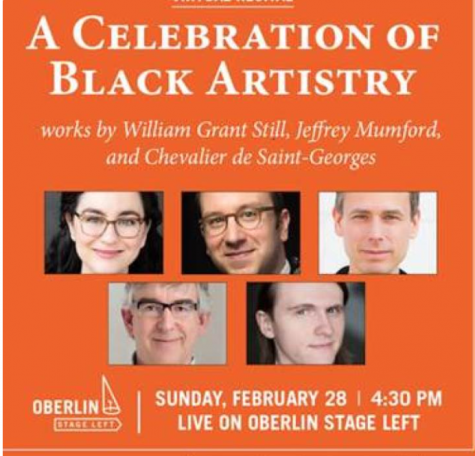After Controversial Flier, Alumni Call on Conservatory to Do Better
The Conservatory received major backlash this week after publicizing a Black History Month event featuring only white musicians.
The Oberlin Conservatory of Music issued an apology last weekend after a controversial flier went viral on Facebook and Instagram. The flier advertised a virtual recital in the Conservatory’s “A Celebration of Black Artistry” series and featured photographs of the event’s all-white performers. Over 2,000 people have reacted, shared, and commented.
The flier was posted on Sunday and deleted that same day, replaced with an apology. In a statement, the Conservatory acknowledged that featuring photos of white artists on the flier was a mistake, but did not comment on the choice to conduct a Black History Month recital with all-white performers—a decision that has sparked discord.

“We acknowledge that it was a mistake to post this event out of context, and without pictures of the composers themselves, and we are deeply sorry,” the statement read. “We will continue to be reflective and consider our policies moving forward in order to prevent a post of this nature from happening in the future.”
The apology linked to the Conservatory’s other Black History Month programming, this year’s Racial Equity & Diversity Action Plan, and Oberlin’s Presidential Initiative for Racial Equity and Diversity.
“While these words guide our work always, this is clearly a day on which we misstepped,” the statement read. “We want you to know that we hear you, and we will do better.”
Conservatory alum Joshua Blue, OC’16, says that he was not impressed by Oberlin’s response. For Blue, the Conservatory’s statement did not address what he sees as a lack of foresight and thoughtfulness from organizers.
“Personally, I fully don’t accept the Conservatory’s apology, because the poster wasn’t the issue,” Blue said. “If you’re going to celebrate Black artistry, you have to celebrate Black artists as well as composers. If it gets to that point where we’re like, ‘Well, we don’t have the faculty to fill these roles,’ then Oberlin has thousands of alumni that could have done this virtually. … It was lazy programming. They worked with what they had within arms reach, as opposed to doing the work and finding the people to perform it.”
When Blue first saw the post, he took to Twitter to express his frustrations. For Blue, the flier signified a much bigger issue: the small number of Black faculty members in the Conservatory. In his post, Blue pointed out that less than 10 percent of the Conservatory’s faculty and staff is Black.
“What example are you setting for not just yourselves, but the entirety of higher education establishments, when you can’t even be bothered to show the same initiatives for diversity and inclusion in the people you have HIRED to teach about it?” Blue’s tweet read. “Diversity is TOP DOWN, it is never the other way around.”
Associate Dean for Academic Support and the Conservatory’s liaison to the Office of Equity, Diversity, and Inclusion Chris Jenkins has stated that, while the flier was a mistake, he sees this month’s complete programming as a step in the right direction. The final recital is one of six events this month that included performances and presentations by Black faculty, staff, and invited guests.
“The truth is that in recent memory—at least during my time at Oberlin, if not previously—the Conservatory has never produced this much programming for Black History Month,” Jenkins wrote in a Letter to the Editor on Wednesday. “Because we are doing something we haven’t done before, we are likely to make mistakes, which is unfortunately what happened in this case; and we ought to continue to produce at least this much programming for Black History Month so as to continue to improve our institutional culture.”
In the past year, the Conservatory has been in conversation with students and alumni about creating a more diverse and inclusive musical education. The Conservatory’s efforts follow a wave of criticism from students. In June, J Holzen’s, OC’20, search through the Conservatory Audio Archives revealed that, since 2010, Oberlin Orchestra, Chamber Orchestra, Sinfonietta, and Contemporary Music Ensemble had performed only seven pieces by five different Black composers. The Oberlin College Black Musicians Guilt and ABUSUA have also issued action steps and a list of demands for building a better community for all.
Following the flier, Blue hopes that the Conservatory will commit to featuring more of its alumni going forward. For Blue, the final recital in “A Celebration of Black Artistry” was a missed opportunity to celebrate Oberlin’s next generation of Black artists.
“Everything we do as artists should not just be for the joy of art, which is a huge component of it, but it should be for the longevity of art,” Blue said. “You can’t inspire artists if you don’t show them that they too have a spot on the stage and in the recital hall.”







